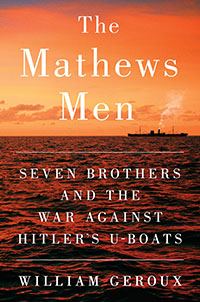Heroes from the Merchant Marine
Journalist William Geroux spotlights the impressive World War II sacrifice of men from small-town Virginia
William Geroux has worked as a journalist in eastern Virginia for many years, and he knows Mathews County well. On the western shore of the Chesapeake Bay, it’s an out-of-the-way, rural peninsula between two tidal rivers. The local economy is based on the land and the bay. Historically, the county’s sons who couldn’t find work nearby left home to join the Merchant Marine. In The Mathews Men, Seven Brothers and the War Against Hitler’s U-Boats, Geroux follows some of those young men into World War II.
 Geroux first describes the county’s history and demographics (population about 7,500 in 1941). Then he launches into context, including discussions of the Merchant Marine (an organization of civilian shipping companies requisitioned by the government during World War II), German U-boats and American submarines, and various events of the war in which supply ships played a crucial role—the invasion of Italy and the launching of the Allied landing force in France, for example.
Geroux first describes the county’s history and demographics (population about 7,500 in 1941). Then he launches into context, including discussions of the Merchant Marine (an organization of civilian shipping companies requisitioned by the government during World War II), German U-boats and American submarines, and various events of the war in which supply ships played a crucial role—the invasion of Italy and the launching of the Allied landing force in France, for example.
The broad sweep of this account provides a gripping story. As soon as war broke out, Germany sent U-boats to attack all Allied vessels. For the first seven or eight months of 1942, they met little resistance and torpedoed freighters at will, at least one a day, mostly along the eastern coast of the U.S. and in the Caribbean. Help from the Navy was scant, and the technology and techniques for countering the U-boat scourge were not yet developed. Within a year, though, a convoy system was instituted, and radar, sonar, and aerial tracking began to sink U-boats and cut Allied shipping losses.
But a key part of U.S. maritime strategy was to mass-produce Liberty ships faster than the U-boats could sink old freighters and to recruit “more merchant mariners than the U-boats could kill,” as Geroux puts it. By war’s end, he notes, “a nationwide recruitment and training program for merchant mariners would expand their ranks from the pre-war total of 55,000 to more than 250,000.” (Afterward, the commercial fleet drastically shrank again as Greece, Liberia, and other nations with fewer regulations and cheaper crews took over the world’s shipping.)
 With the broad sweep of this story, Geroux uses exceptional events, such as the birth in a lifeboat of a Croatian diplomat’s son, to put a human face on big-picture strategy and tactics at sea. In these tales the men of Mathews County, especially the seven sons of Captain Jessie and Henrietta Hodges, are never far from center stage. Personalities and family dynamics in the face of danger and loss humanize what would otherwise have been merely another treatise on the Atlantic sea war.
With the broad sweep of this story, Geroux uses exceptional events, such as the birth in a lifeboat of a Croatian diplomat’s son, to put a human face on big-picture strategy and tactics at sea. In these tales the men of Mathews County, especially the seven sons of Captain Jessie and Henrietta Hodges, are never far from center stage. Personalities and family dynamics in the face of danger and loss humanize what would otherwise have been merely another treatise on the Atlantic sea war.
Geroux paints a portrait of the indefatigable Henny, running the farm in the absence of her husband and sons: sewing, stoking the cookstove, putting on huge dinners for everybody in the extended family when any of them came home between voyages, and giving in at times to unendurable grief. Other Mathews County families with seafaring men suffered staggering losses, as well, especially at the beginning of the war. “In the nine months since the United States entered the war,” Geroux notes, twenty-two Mathews mariners had been killed.” Everybody was crying.
But The Mathews Men offers more than the sweep of history and family tales of hideous loss. Geroux has an axe to grind with history, as well. The civilian Merchant Marine lost roughly 9,300 men in World War II, nearly four percent of its total roster. As Geroux points out, “The only branch of the U.S. military with a comparably high fatality rate was the U.S. Marines.” Clearly, the shipping of goods and weapons to Allied troops was essential to the war effort, yet members of the Merchant Marine seldom won medals or popular recognition for their service, and after the war they were excluded from the G.I. Bill and veterans’ health-care services for many years.
This book, Geroux’s first, represents decades of research and includes many primary sources—letters, personal journals, and interviews with relatives and survivors. With its two sections of photographs, excellent maps, and forty-eight pages of chapter-by-chapter source notes, it is a massive yet readable synthesis, a significant contribution to the heroic service of civilian seafarers in World War II.

Ralph Bowden, who holds a Ph.D. from the University of North Carolina, has worked as an electrical engineer, history professor, home builder, alternative-energy consultant, and technical writer. A former resident of both Knoxville and Chattanooga, he lives in Cookeville.


